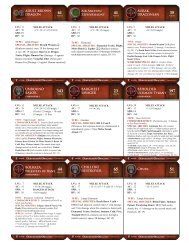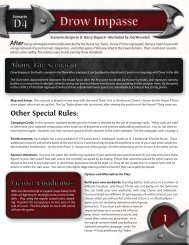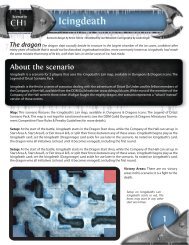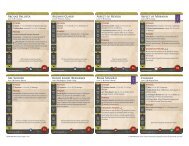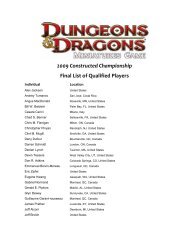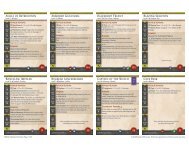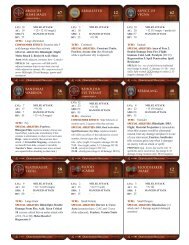You also want an ePaper? Increase the reach of your titles
YUMPU automatically turns print PDFs into web optimized ePapers that Google loves.
Players complete phases in play order until all creatures have been activated. Actions<br />
occurring during a specific creature’s activation are referred to as that creature’s turn.<br />
Playing a Round<br />
1. Initiative Check: 1d20 + best Commander rating. The player with the highest<br />
result chooses who goes first.<br />
2. First Player Phase: Activate 2 creatures, one at a time.<br />
3. Next Player Phase: Activate 2 creatures, one at a time.<br />
4. First Player Phase: Activate 2 more creatures (not those that have already<br />
activated this round).<br />
5. Next Player Phase: Activate 2 more creatures (not those that have already<br />
activated this round). Continue until all creatures have activated once.<br />
6. When all creatures have activated once, the round ends. Start again at step 1.<br />
ACTIVATE CREATURES<br />
During each phase in the round, you activate (move) two creatures, one at a time.<br />
(If you have an odd number of creatures in your warband, on your last phase you’ll have only<br />
one creature to activate.) A creature that activates can take one of the following actions:<br />
• Move up to double speed; or<br />
• Move its Speed and then make one attack, or make one attack and then move; or<br />
• Not move any distance and make all its attacks, if it has more than one; or<br />
• Charge.<br />
Instead of making an attack, a creature can cast a spell or use a special ability that includes<br />
the phrase “replaces attacks,” such as Turn Undead.<br />
Move up to Double Speed<br />
A creature that doesn’t attack (or do something else that replaces attacks) can move up to<br />
twice its Speed on a turn.<br />
Move and Make One Attack<br />
A creature that moves up to its Speed can make one attack or do something that replaces<br />
attacks. It can move first and then attack, or attack first and then move.<br />
No Multiple Attacks: Creatures that move at all on their turn can’t attack more than once. If a<br />
moving creature has more than one attack listed on its stat card, and the attacks deal different<br />
amounts of damage, choose which attack it uses. It can’t use the bonus from one attack and the<br />
damage from another.<br />
Not Move and Make Multiple Attacks<br />
Most creatures make only one attack in a turn. (See Attacks and Damage starting on page 10.)<br />
Some creatures, however, can make multiple melee or ranged attacks in a turn. If a creature<br />
doesn’t move any distance on its turn, it can make multiple melee or ranged attacks if it is<br />
able. All its attacks must be of the same sort (melee or ranged). See Multiple Attacks on<br />
page 17.<br />
Charge<br />
A creature can charge the nearest enemy that it can see, subject to certain conditions. See<br />
Charging on page 13.<br />
9



